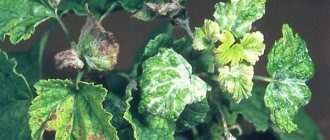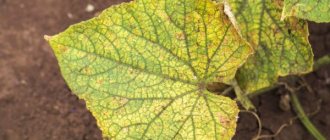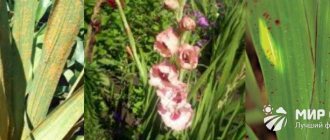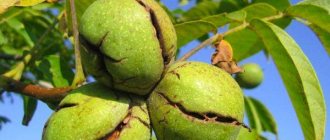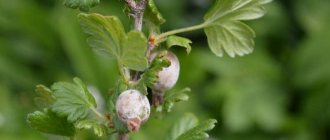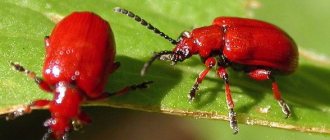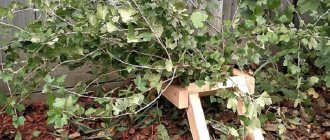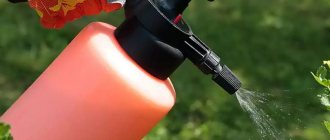Powdery mildew, also called mildew or ashtray, is a fungal disease caused by microscopic fungi of the order Erysifaceae or Powdery Mildew, which live in the ground. Most crops are susceptible to this disease, for example: grapes, roses, gooseberries, cereals, peaches, pumpkins and sugar beets. At the same time, the signs of the disease in each plant are the same, but the pathogens are different. For example, American powdery mildew, which attacks peach, gooseberries and roses, is caused by three different spherotecae.
Features of powdery mildew
The first sign of a plant being affected by powdery mildew is the appearance of a whitish coating of mycelium, with drops of moisture appearing on its surface. Such plaque can form on petioles and leaf blades, on young shoots, and also on the stalks and fruits of various crops. The first to be affected are the stems and foliage, which are closest to the soil surface, after which the disease begins to gradually spread, covering the entire bush. If you look at the plaque carefully, you can see that in those places where the mycelium attaches to the plant, ulcers form. It gradually fades and loses its decorative effect, since the fungus takes nutrients from it, and in addition, the process of photosynthesis is disrupted in foliage that has plaque. A crop affected by this disease becomes less resistant to frost. Cracks appear on those fruits that are affected by the disease; rot pathogens can penetrate through them, which leads to secondary infection.
Fungi are most active under the following conditions:
- during prolonged rains or with high air humidity (from 60 to 80 percent) at a temperature of 15–27 degrees;
- there is often a sharp change in temperature;
- after radical pruning carried out to rejuvenate the plant;
- the soil contains an excessively large amount of nitrogen;
- plantings are very thick;
- the wrong watering mode is chosen, or more precisely, if the soil often dries out or there is regularly stagnant water in it.
How to recognize powdery mildew, photo, how it begins
Manifestation on tomatoes
The disease can manifest itself on completely different cultivated plants. Let's talk about how to recognize powdery mildew in the early stages.
Manifestation on cucumbers
Powdery mildew appears as a whitish “fluffy” coating on leaves, fruits and stems.
Disease on currants
The disease begins as the appearance of small white spots. Soon they grow, covering the entire leaf blade or fruit.
Disease on gooseberries
Liquid is gradually released and remains on the infected part of the plant.
Disease on roses
Many crops are susceptible to the disease. For example, gooseberries, currants, acacia, hawthorn, pear, oak, strawberries, roses, peaches, tomatoes, cucumbers, indoor flowers.
Infected violet
The disease begins to spread from the lower part of the plant, since the fungal spores are mainly found in the soil.
Sick apple tree
Ways to fight
Treatment of powdery mildew
If you are sure that the crop is affected by powdery mildew, you need to remove as soon as possible all flower stalks and leaf blades that have turned yellow and wilted. Sometimes you have to cut off a significant part of the foliage, but you should not be afraid of this, since by removing the affected parts of the plant, you increase the chances of its recovery.
Next, carefully treat the diseased bush with a fungicidal preparation; the solution should thoroughly moisten all its above-ground parts. In this case, the medicinal mixture during treatment should flow down the plant as if it had just rained very heavily. If a crop growing in open ground is being treated, then along with it the surface of the soil in the bed or in the tree trunk must also be treated with a solution of a fungicidal preparation.
This disease can also affect house plants, what should you do in this case? After the bush has been well treated with fungicide, they should also spray the walls of the container in which it grows and the surface of the substrate. If the plant is very badly affected, then the top layer of the soil mixture, which contains a colony of fungal mycelium, will have to be removed from the container, and a new substrate will be poured in its place, which must first be disinfected.
Prevention measures
In order to get rid of powdery mildew you need an integrated approach. In addition to mandatory chemical treatments, special agrotechnical measures are used:
- Watering is carried out only when the top layer of soil has dried well;
- in autumn, the area must be cleared of plant debris, which is then destroyed;
- it is necessary to adhere to the rules of crop rotation;
- for cultivation, choose hybrids and varieties that are highly resistant to powdery mildew;
- do not add too much nitrogen fertilizer to the soil, especially during the formation of buds;
- timely apply phosphorus-potassium fertilizers to the soil, as they help increase the crop’s resistance to disease;
- in spring, it is necessary to carry out sanitary pruning of bushes and trees;
- Regularly spray trees and bushes with a fungicidal preparation for preventive purposes; this is done in early spring and after leaf fall.
For preventative purposes, plants are also sprayed with other chemicals that are used to combat powdery mildew. For example, bushes are pollinated 3 or 4 times with sulfur; you can also spray them 3 times with a solution of Bordeaux mixture, copper sulfate or another product that has a similar effect.
Powdery mildew: control and prevention methods.
Fighting the disease using agrotechnical methods
Treatment with different compounds is not the only way to cure the disease. Some agricultural practices also help to cope with it.
So, the most important thing in the fight against powdery mildew is proper watering. You only need to pour water when the top layer of soil dries out. It is also worth mentioning here about mandatory loosening and mulching.
Loosening will provide access to air and will not allow liquid to stagnate at the roots, and mulching will prevent excessively rapid evaporation of moisture.
As soon as you begin to fight the disease, you must immediately exclude any foliar feeding.
If the disease appears on flowers, take the pots to a sunny place. The sun is your assistant in the fight against powdery mildew.
Powdery mildew on vegetables
cucumbers
If cucumbers are affected by powdery mildew, then both fungicidal preparations and folk remedies can be used to treat them. However, it is impossible to get rid of powdery mildew on this vegetable crop without preventive measures. First of all, you must adhere to the rules of agricultural technology for cucumbers, and the beds must be sprayed with a solution of Quadris (strictly follow the instructions on the package). But in some cases, the disease still affects the plant, even despite preventive measures.
What to do to cure cucumbers? To treat such a vegetable crop, you can use both folk and chemical remedies. However, no matter what you choose, before you begin processing, you must remove and destroy all parts of the bush affected by the disease.
Dusting the plant with sulfur powder helps quite well in the fight against powdery mildew, with 25 to 30 grams of the drug taken per 10 square meters of planting. You can also spray cucumbers with a solution of colloidal sulfur (25 to 30 grams per 10 liters of water). They also fight powdery mildew on this crop with the help of mullein infusion, which also needs to be used to treat the bushes.
Of the fungicidal preparations, Topaz or Oksikhom are most often used in this case; if you decide to use them, then be sure to strictly follow the instructions attached to the product.
Tomatoes
On tomatoes, powdery mildew can appear due to 2 types of fungi. One of them is Oidiopsis erysiphoides, which most often affects bushes grown in greenhouse conditions. As a rule, this happens in March if the greenhouse was not disinfected before planting the seedlings. The leaf blades of the affected seedlings begin to dry out at the edges; if you do not start treating them in time, there is a high probability that they will die. Another causative agent of this disease is Oidiopsis taurica. In tomatoes affected by such powdery mildew, yellow spots form on the front surface of the foliage. At the beginning, a whitish coating forms only on the underside of the leaf blades, but as the disease develops, it also appears on the upper side of the foliage.
In order to prevent tomatoes from being affected by powdery mildew, you need to adhere to the preventive measures that were described above. And before sowing, it is recommended to immerse the tomato seed material in a solution of Epin or Immunocytophyte for 42 hours. However, if a vegetable crop is nevertheless affected by powdery mildew, it is necessary to begin combating it as soon as possible. It is recommended to spray young plants with a solution of sodium humate; it can completely suppress the germination of conidia, which are the causative agents of this disease. Tomatoes are processed regularly once every six months, and the instructions must be strictly followed. Also for this purpose, you can use biological preparations that are specially designed to combat powdery mildew. For example, you can use Baktofit solution (1%), which should be sprayed on tomatoes 3 times with a break of 1–1.5 weeks. In this case, treatment should begin immediately after the first symptoms of the disease appear. You can also cure tomatoes with the Planriz cultural liquid, which the bushes also begin to treat after the first symptoms of the disease appear.
Of the fungicidal preparations, the most effective are: Strobi, Topaz, Quadris, Tiovit Jet, Bayleton and Privent. In order for the product to “stick” better to the sprayed plant, a small amount of laundry soap or silicate glue should be added to the solution. For those who do not want to use chemicals to treat vegetable crops, whey (10%), wood ash or skim milk can be used for treatment and prevention.
Zucchini
If powdery mildew has infected the zucchini and a white coating has formed on them, it is necessary to cut off and destroy all diseased leaf blades and stems, and also dig up the soil surface around these bushes. In order to cure plants, they can be treated with a solution of wood ash, soda ash or mullein. Most often, gardeners use chemicals such as Carboran, Kephalon or sodium phosphate, as they are very effective in combating this disease.
Preventive spraying is carried out at the beginning of the spring period with a Nitrafen solution. For medicinal purposes, treatment is carried out before the plant blooms and after flowering, using the same drugs that were described above. When using fungicidal agents, at least three treatments will be required, which are carried out with an interval of 1–1.5 weeks, while zucchini is treated regularly with folk remedies every two days. It is recommended to carry out treatments in the evening on a fine day.
Eggplant
Eggplants affected by powdery mildew can be cured with a solution of soda ash, and for this you can also use any fungicidal drug, for example, Fundazol (10 grams per 1 bucket of water). For the plants to recover completely, they will need at least 4 or 5 sprayings with a break of seven days.
Onion
Onions are susceptible to downy mildew (downy mildew). This fungal disease is also very dangerous for vegetable crops. Its development is promoted by low temperature and high humidity. The causative agents of this disease are transmitted by raindrops or wind, and also by plant debris.
SODA and SOAP are the BEST remedy for powdery mildew on: cucumbers, zucchini, currants and other plants
Symptoms and causes of the disease
Powdery mildew is a fungal infection caused by pathogenic microorganisms.
The disease is caused by various types of pathogenic fungi:
- Fruit-bearing trees and shrubs are affected by Sphaerotheca mors;
- For flower crops, the class of organisms Sphaerotheca pannosa is dangerous;
- Cereals are susceptible to attack by the fungus Erysiphe graminis;
- For pumpkin crop species, Erysiphe cichoracearum and Sphaerotheca fuliginea are dangerous.
The disease is very insidious. First the plant becomes depleted, then it rots and dies.
Signs of illness
Characteristic symptoms of the disease will be the appearance of a fluffy white coating on the surfaces of leaves, stems or young shoots. The source of infection is in the soil, so the first signs of infection can be seen on the lower part of the plant (whitish spots with a diameter of 0.2-0.4 mm appear in the area of leaves close to the ground). The plaque then spreads higher. The first stage is the appearance of white spots, then fungal spores mature and drops of liquid form on the surface of the spots. After this, the whitish coating thickens and acquires a grayish tint with small black dots.
If you examine these formations under a microscope, you can observe a dense web of mycelium - mycelium threads that are constantly growing. The proliferation of mycelium on the planting disrupts the process of photosynthesis, which leads to defective development. Growth slows down or stops altogether, leaves die, buds do not bloom, young shoots look defective.
On fruit trees and bushes, in the presence of the disease, wood does not form on young shoots, as a result of which the plants do not tolerate frost well and often die in winter.
Causes
Dew itself is excess moisture condensed from the air, which appears on surfaces that are cooler than the atmospheric temperature. Forms on leaves and tips of grass, mainly in warm and windless weather.
Powdery mildew fungus spores are not active in hot and sunny climates. Reproduction occurs in high humidity and cool weather. The most favorable environment for the development of infection is soil saturated with nitrogen. Fungal spores are carried through air and water. Once on a plant, the fungus quickly spreads over the entire area, releasing tiny drops of liquid, which is why the infection is called “powdery mildew.”
Factors that provoke the appearance and development of the disease include:
- Improper watering (excessive flooding or, on the contrary, lack of moisture);
- Neglect of disinfection measures (when there are already infected plantings on the site, without observing measures for disinfecting working tools and hands, it is easy to transfer the disease to still healthy plantings);
- Planting crops too densely, which prevents the free passage of air between plants.
Fighting powdery mildew on shrubs and trees
Currant
Currant bushes affected by powdery mildew are difficult to miss. And if you do not immediately begin to fight this disease, then by the second half of the summer period the entire currant tree may be affected. It doesn’t matter which currant is affected by powdery mildew, black, white or red, this disease is equally dangerous for it.
You can try to cure diseased currant bushes using both folk remedies and chemicals. You need to spray the bush on each side, and try to ensure that the medicine solution gets not only on all leaf plates, but also on each of its surfaces: both the top and the bottom. You can treat the plant either with a sprayer or with a brush with soft bristles. The processing of currant bushes should be done in the evening at sunset, and you need to choose a dry, sunny day. Treatments should be carried out for at least four weeks, and the bush should be sprayed at least once every seven days.
Also, folk remedies that have been tested by time are often used to treat currant bushes. For example, they can be treated with soda ash, whey, a solution of wood ash or cow manure, a pinkish solution of potassium manganese, dusted with sulfur, etc. As a rule, folk remedies are used only at the initial stage of the development of the disease, but if the bushes are very badly affected , then you will have to use special chemicals. In spring, they are treated with a solution of Nitrafen or iron sulfate (30 grams per bucket of water), you can also use copper sulfate (10 grams of the drug per bucket of water). During the formation of buds, a solution of copper oxychloride is used to spray the bushes, for the preparation of which a bucket of water is combined with 30 grams of the drug or Bordeaux mixture (1%). When the currants fade, they are treated with soda ash twice or three times with a break of one and a half weeks. In autumn, all plant debris must be removed from under the plants.
Gooseberry
The methods of combating powdery mildew on gooseberries are exactly the same as those used to treat currants. To spray such crops, kefir, cow manure, wood ash, whey, yogurt, baking soda or soda ash are used, as well as a decoction of tansy or horsetail and an infusion of onion husks or rotted hay. The most effective chemicals in the fight against powdery mildew are Gaupsin, ammonium nitrate and Trichodermin. And Fitosporin in treating the disease is as effective as when treating late blight.
Grape
The powdery mildew that can affect grapes is called oidium. The first symptoms of such a disease are the same whitish coating that forms on shoots, fruits, foliage and stems. The disease develops most actively at high air humidity and temperatures from 18 to 25 degrees, but during rains there is a slowdown in the spread of infection. In the summer, when the air temperature does not drop below 20 degrees, the grapes are treated with sulfur, so for treatment they use a solution for the preparation of which they combine 1 bucket of water and from 80 to 100 grams of the drug, and for preventive purposes, from 25 to 100 grams of the drug are used to make the mixture. 40 grams of substance per 10 liters of water. If the weather is cool, then sulfur preparations are used for treatment, for example, a solution of colloidal sulfur. But during the formation of fruits, it is not recommended to use chemicals for processing. At least 30 days before harvest, you must stop spraying grapes with drugs that are toxic to the human body.
During fruit filling and ripening, grapes affected by powdery mildew can be treated with a pinkish solution of potassium permanganate, this will stop the development of the disease. And after all the fruits have been collected, chemicals can be used to treat the plants. Such a crop can be treated with fungicidal drugs, the most effective in this case will be: Tiovit Jet, Quadris and Topaz.
Apple tree
If apple trees are severely affected by powdery mildew, this can have an extremely negative impact on their yield, reducing it by half. In addition, apple trees may become less resistant to frost. This disease poses a great danger to nurseries, as it spreads very quickly from tree to tree.
There are also effective remedies that will help cure apple trees and other fruit trees from powdery mildew. Most often, a solution of soda ash mixed with soap, colloidal sulfur or copper oxychloride is used to treat the affected plant, and spraying is carried out regularly once every three or four days. Topaz also helps very well in the fight against powdery mildew on apple trees, and for the purpose of prevention they begin to be treated from the beginning of the growing season. If the plant is already affected by the disease, then it will have to be sprayed with Topaz solution 3 or 4 times with a break of 6–12 days. In order to prevent the spread of the disease, before starting treatment, all affected parts of the tree are cut off and destroyed.
Strawberry
If a strawberry is affected by powdery mildew, then this can be understood by the whitish coating that forms on the underside of the leaf blades, because of this, over time they become leathery to the touch, while their edges curl and turn bronze. The highest concentration of powdery plaque is observed on the tendrils, as well as the central leaf blades. Fruits formed on a diseased bush also develop a white coating, and they also develop a moldy smell. For preventive purposes, do not allow plantings to thicken; to do this, strawberries need to be regularly thinned and replanted. To treat diseased plants, use a suspension of colloidal sulfur (1%) or TMTD, as well as such products as Bayleton, Switch, Quadris or Fundazol, and spraying is carried out after the bushes have flowered, as well as after harvesting. When spraying, try to wet both surfaces of the leaf blades with the product.
SODA IS THE BEST REMEDY TO COMBAT Powdery Mildew
Biofungicides
These products of biological origin contain live bacteria that inhibit the proliferation of pathogenic fungi. Due to their environmental safety, biofungicides can be used to treat plants even during fruit ripening.
Their effectiveness in treating powdery mildew is lower than that of chemical drugs, as is the period of action (multiple applications are required). Therefore, biological preparations are optimally suited for plant protection (prevention).
The most common biofungicides for combating powdery mildew: Alirin-B, Pseudobacterin-2 and Fitosporin.
"Fitosporin"
This drug can be used effectively only for prevention, protection of a plant, bush or tree, or with very early detection, and it is not suitable for treatment. Price: 10 g – 15 rubles.
Powdery mildew on garden flowers
Phloxes
Not only vegetable, fruit and berry crops, but also garden flowers are susceptible to powdery mildew. For example, a whitish coating in the middle of summer can form on the foliage and shoots of phlox. As the disease progresses, it changes its color to a darker one and eventually becomes dirty brown. Because of this, the decorative quality of plants suffers greatly.
If the first symptoms of the disease were found on the phlox, then you need to cut off all the affected leaf plates from the flowers as soon as possible and dig up very diseased bushes, after which they are burned. The remaining plants need to be sprayed with a solution of colloidal sulfur (1%), and several treatments are carried out with a break of seven days. As a preventive measure, the surface of the soil in the flower bed is covered with a layer of mulch (peat or humus), and in early spring, after the height of the stems is 100 mm, the bushes are sprayed with a solution of Bordeaux mixture; 3 treatments will be needed, which are carried out once every 12–14 days. In order for the flowers to be more resistant to this disease, it is recommended to use a complete mineral fertilizer as a top dressing.
Roses
Powdery mildew affects a variety of flowering plants, and roses are not spared. If the bushes are very strongly affected, then all the foliage on them will curl up, dry out and fly off ahead of schedule, while a felt coating will form on the surface of the bare stems and shoots, which will prevent the flowers from growing and developing further. In order to prevent the development of this disease, the surface of the area near the roses should always be clean, and try to remove weeds almost immediately after they appear. In the autumn, when the leaf fall ends and sanitary pruning is carried out, the area must be cleared of all plant debris that should be destroyed. And the surface of the soil under the bushes needs to be dug up.
As soon as the first signs of disease are detected on the bushes, you need to start treating them immediately. To do this, use a solution of Fundazol, Maxim, colloidal sulfur or Fitosporin-M. At the beginning of spring or in autumn, it is recommended to spray roses against powdery mildew with the following mixture: for 1 bucket of water, take 0.3 kilograms of green soap, 15 grams of copper oxychloride, and another 50 grams of soda ash.
Petunia
Petunia is also susceptible to powdery mildew. A whitish coating appears on the surface of the bushes, which over time spreads to all above-ground parts of the plant. Due to this disease, rot forms on the flowers and they die. In order to save them, you should cut out all the affected areas of the petunias and destroy the ear, after which the flowers are treated with a fungicidal agent, for example, Skor, Previkur, Topaz or Fundazol. In the case when flowers are grown not in open ground, but in a container or pot, it is necessary to remove the top layer of the substrate and replace it with fresh soil mixture, which is pre-treated with Fitosporin-M.
Of all the folk remedies used to combat this disease on petunia, treatment with ash or soap-soda solution shows the greatest effectiveness, and for this purpose you can also use potassium permanganate, whey, mustard or garlic infusion.
Violets
In garden violets, also called viola, foliage, buds and shoots suffer from powdery mildew. The most common causes of the development of the disease are: an excessively large amount of nitrogen in the soil or heavy morning dew on a dry, fine day. Diseased bushes become less spectacular, and they also bloom much less than expected. In this case, to cure the flowers, they use chemicals such as: Topsin-M, Fundazol, Morestan, Fthalan, Kuprozan, Zineb, and the bushes can also be sprayed with a solution of soda ash, to which a little soap is added.
Powdery mildew / Prevention and control measures
Features of the disease
Before starting the prevention or treatment of garden, garden, and ornamental crops, it is necessary to find out what it is - powdery mildew (ashtray), its symptoms and causes. The pathogen is the powdery mildew fungus Erysiphales, which parasitizes plants (leaf blades, stems, shoots, ovaries). Spherotheca fungi live in the soil and are activated under favorable conditions:
- poor care of plantings (the appearance of weeds, irregular watering);
- thickened plantings;
- excess nitrogen fertilizers in the soil;
- cool weather (+16ºC…+22ºC);
- high air humidity.
Often, infection occurs when there are strong differences in night and day temperatures, as well as in the absence of preventive treatments. During rains, the spread of infection slows down; after the cessation of precipitation, when moisture evaporates from the ground, the growth of the sphere library begins.
Pathogen spores are transferred with precipitation, through the air, through hands (for example, when cutting off an already diseased plant and then proceeding to form a healthy one), when watering through water. The disease is dangerous for most vegetable and garden crops, flowers, and berry fields. Powdery mildew affects:
- cucumbers;
- pumpkins;
- zucchini;
- tomatoes;
- grapes (oidium);
- currants;
- gooseberry;
- roses;
- violets;
- phlox;
- petunias.
On a note! Young leaves of plants are most affected by powdery mildew when they are 18-20 days old.
Specifics of the disease: pathogens suppress living plant cells, but the leaves do not fall off and the plant itself does not die for a long time. This is explained by the characteristics of the fungus, which is part of the group of obligate species and lives as long as the host’s body functions.
Signs of the appearance of powdery mildew (see photo):
- the appearance of small white spots on some sheets (on the upper side);
- a white coating gradually covers the above-ground part of the plants;
- the bushes seem to be covered with a cobweb layer (mycelium of the fungus).
- gradual yellowing of parts;
- the appearance of necrotic areas and ulcers
- deformation and sagging of leaves.
Parasites take all nutrients from a living organism, plaque interferes with the processes of photosynthesis. The spores are instantly spread to other plantings, affecting large areas.
Powdery mildew on indoor plants
Some house flowers are also susceptible to powdery mildew, for example: begonia, cissus, Saintpaulia, gerbera, rose and Kalanchoe. As a rule, the disease begins to develop due to stale air with high humidity, sharp temperature fluctuations day and night, and dry soil mixture. The causative agents of such a disease can be transferred from an affected bush to a healthy one by air flow, pests, or during contact with each other (containers with flowers are very close). You can tell that a flower is sick by the resulting whitish spots that can be found on both surfaces of the leaf blades, as well as on the buds. Immediately after detecting such symptoms, you need to start fighting the disease. If treatment is started too late, then the flower may lose its decorative effect, and rot may also appear on it. At the very beginning of the development of the disease, the bushes can be treated with garlic infusion or a solution of potassium permanganate or soda ash. If the plant is very sick, then you cannot do without chemicals; in this case, use Skor, Hom, Vectra, Bayleton, Fundazol, Vitaros, Topaz or Thiovit Jet. Before preparing the solution, you must carefully study the instructions attached to the drug.
As preventive measures, you should properly water the flowers, feed them with phosphorus-potassium fertilizers, systematically ventilate the room, and also remember to maintain plant hygiene.
Powdery mildew
Preparations and folk remedies for powdery mildew
Chemicals
The most commonly used chemicals in the fight against powdery mildew are: Skor, Quadris, Hom, Vectra, Thiovit Jet, Fundazim, Fundazol, Vitaros, Bayleton, Fthalan, Tsineb, Kuprozan, Topsin-M, Fitosporin-M, Previkur, Switch, Bordeaux mixture, copper sulfate, copper oxychloride, colloidal sulfur, etc. These products can be purchased at a specialized store, but they must be used strictly following the instructions attached to the drug, and in no case increase the dosage yourself.
If fungicides were chosen to spray home flowers affected by powdery mildew, then the procedure will need to be carried out outside, and safety precautions must be observed. It is recommended to spray fruit bushes and trees, as well as berry and vegetable crops, with such chemicals only if they are very seriously affected; however, during active fruit growth, all chemical treatments should be suspended.
EXCELLENT REMEDIES FOR Powdery Mildew!
Folk remedies
At the initial stage of disease development, folk remedies are usually used to treat plants. There are many time-tested folk remedies that are absolutely not dangerous for both humans and cultures. Eg:
- Soda and soap solution . To prepare it, you need to dissolve 20 grams of liquid or grated laundry soap, as well as 50 grams of baking soda or soda ash in one bucket of water. The plant should be sprayed at least twice with a break of 7 days.
- Whey solution . In order to prepare such a remedy, you need to combine 1 liter of whey with 1 bucket of water. Spraying with a well-mixed mixture is carried out on a dry, sunny day; there should be at least three such procedures with intervals of three days.
- Kefir solution . To prepare the product, you will need a liter of fermented yogurt or kefir; it is diluted with water in a ratio of 1:10. Three treatments will be required at an interval of three days.
- Horsetail . A decoction is prepared from horsetail; for this, 100 grams of herb are mixed with a liter of water. The mixture is allowed to brew for 24 hours, and then brought to a boil and kept on low heat for a couple of hours. When the broth has cooled, it is filtered and mixed with water in a ratio of 1:5. To completely cure the plant, at least 3 or 4 sprayings will be required, which are carried out with a break of five days. An undiluted decoction, placed in a cool and dark place, retains its properties for seven days.
- Mustard . In one bucket of lukewarm water you need to dissolve 2 large spoons of dry mustard powder. The resulting solution is either watered or treated with the diseased plant.
- Potassium permanganate . To make such a solution, you need to mix a bucket of water with 5 grams of potassium permanganate. This mixture helps to stop the development of the disease, and it also removes the fungus from the surface of the fruit.
- Wood ash . For 1 bucket of water take 1 kilogram of ash. The infusion will be ready after a week. It is carefully drained and 20 grams of grated laundry or liquid soap are added to it. The plants are sprayed with the product regularly every two days.
- Cow dung (mullein) . Combine water and manure in a 3:1 ratio and mix everything well. The infusion will be ready after 3 days. It must be carefully drained and diluted with the same amount of water. Crops are sprayed with this product before they bloom, after flowering, and also shortly before the leaves begin to fall.
- Garlic . To prepare the infusion, add 50 grams of garlic pulp (chopped cloves along with garlic shoots) to a couple of liters of water. After a couple of days, the product is filtered and used undiluted for treatments.
- Onion peel . 1 bucket of boiling water is combined with 200 grams of onion peels. The infusion will be ready after 2 days; all you have to do is strain it. Treatment of crops is carried out before flowering, after the bushes have faded, and even before the leaves begin to fall.
229. Soda and aspirin against powdery mildew
Common mistakes
Now let's figure out what the most common mistakes are in the fight against powdery mildew.
- No preventive measures are taken. It is much easier to prevent a disease than to deal with its consequences later.
- Removed diseased parts of plants are not destroyed. It is very important to burn diseased plants to destroy the fungus. If this is not done, the pathogen will again move to healthy plants.
- A single or light treatment is carried out. The key to cure is copious spraying with fungicides. Most often, the treatment needs to be repeated 1-2 times to achieve a sustainable effect.
- Diseased fruits are eaten. This may cause poisoning, diarrhea and nausea.
